home | metro silicon valley index | the arts | visual arts | zeroone
ZeroOne San Jose + ISEA2006:
Quasi-Blog | "Art on the Edge" by Gary Singh | "ZeroOne In and Out" by Michael S. Gant | Welcome | Let's Go ZeroOne San Jose | Performances | Cinema | Events | Get Your Learn On! | Participate! | People's Choice Award | Map | Featured Exhibits | Exhibits | Staff
ZeroOne—A Virtual Diary
Last Day of ZeroOne
By Gary Singh
Troika Ranch put on a spectacular event at the San Jose Repertory Theater. and only one person walked out. The performance was titled 16 [R]EVOLUTIONS and dealt with the concept of evolution, that is, beginning with prehuman animalistic drives and ending with the post-intellectual humanoid.
Now, Troika has performed this work in Europe a few times—in fact it was developed while they were in residency in England—but it was not until they made it to Fresno when folks started complaining about the partial nudity. The event organizers in that fair city were aghast and insisted on Troika placing signs outside the theater warning attendees that the performance included partial nudity.
Four dancers comprise the show—two men and two women—and the women are topless for about half the performance. I don't know why the one person in the audience walked out, but it had something to do with a topless modern dancer glaring right in his face. John Ashcroft would have abhorred it. Anyway, Troika uses a camera with motion-sensing technology, so the dancer can actually affect the digital graphics being projected behind him or her. Throw in an abstract electronic music soundtrack. and you've got a rocking experimental show.
That same night, a diverse block party took place on South First Street to close out the ZeroOne festival. There were three stages: one at the parking lot near Anno Domini, one in the parking lot at Market and San Salvador, and one at the First and William, sponsored by MACLA, where DJs pounded out the beats. As I arrived, a Japanese metal band was playing at the Anno Domini stage.
On the other parking lot stage, several artists performed throughout the night. An electronica band jammed while Mark Johns cranked out the video accompaniment. Another group used electronic circuit boards to create improvised sound. And near the end of the night, San Jose's own art collective, C5, announced the winner of their festival-long project—the winner receiving a residency at Villa Montalvo for the next ZeroOne festival. (At least I think that's what the prize was.)
If you attended the festival, C5 were those wackos driving the little yellow two-seat cars around downtown. You see, the cars normally operate in San Francisco and use GPS technology to provide audio descriptions of certain SF landmarks as you drive by them. C5 acquired the cars and rewrote the software so it applied to San Jose instead. And several other artists somehow competed by sitting in the passenger seats, the winner getting the residency. That's about all I understood about the project.
But perhaps the most impressive project at the block party was instigated by the San Jose Institute of Contemporary Art, which was celebrating its new permanent location at 560 South First with a raging party. To help celebrate, new-media artist Clive McCarthy presented an interactive painting performance up the street. Several artists painted an architectural portrait of the façade of the old location of the San Jose Institute of Contemporary Art. The Del Sol String Quartet performed simultaneously in the street. In fact, they were complaining about the nose from the Market & San Salvador stage.
So there you have it. A string quartet performing works by avant-garde composer George Antheil while a Japanese metal band plays two blocks down the street. Now that's variety—the key component of the ZeroOne festival.
Posted Aug. 15, 2006
Aug. 12
By Gary Singh
You know, it's not every day that one can walk around the corner from his office and see a Survival Research Laboratories show, and a fully sanctioned legal one at that. When Survival Research Laboratories announced that this show for the ZeroOne festival and ISEA 2006 would take place in the parking lot next to the South Hall of the McEnery Convention Center, we were all dumbfounded and flabbergasted that San Jose would actually allow them to do this. This is a city where it takes a year of wrangling over permits just to open a freakin' hot dog stand, let alone an SRL show. As the time grew near, I talked to festival director Steve Deitz on the phone and the conversation went something like this:
"You mean this is actually going to happen? They have the permits from the police and the fire marshall?"
"Yeah, there's still some I's that need to be dotted, but it's not police and fire."
"So this is public information?"
"Yeah."
"So I can put this in the paper ahead of time?"
"Yeah."
"You're sure?"
"Yeah."
And that was that. To be honest, I was somewhat apprehensive about including SRL in that cover story. If it somehow alerted the wrong regulatory institutions and resulted in the show getting shut down, I would have felt awful. But as a journalist, it's our job to tell a story, so what the hell, I did it. Hardly anybody in San Jose knew what the ZeroOne festival was really all about, and I had to write something about it.
Anyway, we stood in line for probably half an hour inside the South Hall on our way out to the parking lot. The crowd was huge, probably at least 2,000 people. As soon as I walked out into the lot, I heard Glenn Campbell's "Rhinestone Cowboy" emanating from the PA system mixed with audio from someone playing the original version of Space Invaders. After hearing that, I knew it was going to be a great show—the only one of its kind ever in San Jose.
The show, titled, "Ghostly Scenes of Infernal Desecration," didn't go off exactly as planned, as a few of the machines broke down. The Running Machine conked out early and the Air Launcher broke down about two-thirds of the way into the show. SRL's Mark Pauline ran over and tried to get both machines working, but to no avail.
Also, this was a much quieter and more contained SRL show than usual. The Hovercraft, which is normally the most excruciatingly loud machine, wasn't working properly, and although SRL set up the Shockwave Cannon, it didn't seem like they even used it. So without those two machines working at 100 percent, much of the beautifully insufferable volume was lost. It was still a loud show, of course, but nowhere near as loud as usual.
Probably at the request of the regulatory institutions, a double layer of barricades surrounded the parking lot and most of the conflagration took place on the opposite side of the area from the audience. You just didn't feel the usual sense of imminent danger that you usually do at an SRL show.
Other than those minor setbacks, it was rocking show and a huge success. The San Jose Fire Marshall probably grew quite a few gray hairs as the spectacle progressed. Afterward, the crew opened up the space so everyone could hang out and get close to the machines, the wreckage and the burning embers. One crew member rolled out a Margarita bar with a pig's head on it and then poured 'em for the crew. I freeloaded a few and then escaped around the corner.
Posted Aug. 14, 2006
Aug. 11
By Gary Singh
A panel session took place at ISEA 2006 featuring the five artists/teams who were awarded residencies at Villa Montalvo for the symposium: Shona Kitchen and Ben Hooker, who created the DataNature project; Antonio Muntadas, whose On Translation project will grace an inside wall of the Convention Center for the next two years; Katie Salen, Nancy Nowacek and Marina Zurkow of the Karaoke Ice project; Cobi van Tonder, who came up with the Skatesonic project; and Bombaby native Ashok Sukumaran, who created the Park View Hotel piece. Of all the folks taking notes, I was the only one without a laptop.
Moderator Gordon Knox declared that the discussion would center on a variety of ways that ideas move in and around the globe. He went on to explain that residencies are about the process, not the product—and about the artist rather than the community.
Back in the late 19th century, artist residencies were treated pretty much like retreats to get the artist out of his or her regular environment and help him or her produce. Nowadays residencies are more like laboratories for critical inquiry and creative practice. At least with the Montalvo residencies, it doesn't matter if the artist even has a specific product already started. It's all about establishing a network of interrelations.
Speaking of that, almost all of the artists said that this was a very unusual residency compared to the others in which they've participated, in the sense that this time they were deadline-driven and that they were collaborating with institutions from the industry of Silicon Valley. All of the artists said it was weird that they were all shacked up in the same place, but they never got a chance to talk to one another. Salen, a designer, said that Karaoke Ice was probably more of a design project than an art project.
Knox himself was a master at moderating the panel session and you can tell he's done it many times. He would listen to a person's answer and chime in immediately with a complete explication of what the person said. Bravo! On a separate note, outside in the courtyard, folks gathered around a table and crouched over circuit boards. They were taking a free workshop on how to build an FM radio transmitter. Ah, the sheer variety of ISEA!
As I migrated back toward South Hall, Survival Research Laboratories were just beginning the process of barricading off Viola Avenue behind the convention center in preparation for the show later on that night.
Posted Aug. 11, 2006
Aug. 9
By Gary Singh
The 13th International Symposium for Electronic Arts (ISEA2006) received more 1,800 submissions overall, and nearly 200 judges around the globe took part in the jurying process. The paper sessions began in Parkside Hall on Wednesday (Aug. 9), and the setup was over the top. Three huge video screens behind the stage gave the attendees a large glimpse of the conversations taking place on the stage. Instead of having each individual researcher stand there and present his or her paper—the norm in an academic conference—the ISEA 2006 organizers decided to have a handful of folks discuss the topics of their papers onstage in an informal fashion. Several other video screens were dispersed throughout the audience.
Then came the poster sessions. In case you're not familiar with academic conferences, a poster session is sort of like the next rung below a paper session. Instead of the researcher presenting his or her paper for the conference delegates and then taking questions afterward, the person stands in front of a poster that demonstrates his or her research, and conference attendees peruse the posters at will. In this case, the perusing involved food and alcohol.
Here are just a few examples of what's there: Kenneth Field's "Chinapedia" explored the new media situation in China and how that country is moving from the slogan "Made in China" to "Created in China." Chris Byrne's "Free Radio and Commercial Networks" re-examines the role of radio broadcasting and how everyone fetishizes the new and underestimates the role of second-tier media. A projet by Julie Freeman and David Muth called "The Lake" involves electronically tagging the movement of fish and turning the data collected into music and visuals.
Later that night, South African artist Cobi van Tonder unleashed the Skatesonic project in the courtyard outside Parkside Hall, an ISEA project sponsored by IDEO in Palo Alto and Villa Montalvo in Saratoga. Several skaters took to the ramp, riding custom boards equipped with sensors that piped information to MAX/MSP software to drive the music. With interactive projects like this, the main issue is whether or not the audience can actually tell how the interaction is taking place—that is, if you can't tell how the skateboard is directly affecting the music, then the music just comes off as being a soundtrack. In this instance, it was about half and half. Sometimes you could tell, and sometimes you couldn't. That, along with the planes constantly flying overhead, made for a pretty good party. Many young kids showed up, and many of the adults pounded beers. It was a splendid warm summer evening.
Posted Aug. 11, 2006
ZeroOne Photo Gallery
By Felipe Buitrago
Akira Hasegawa's Digital Kakejiku San Jose. Living light projections on City Hall.
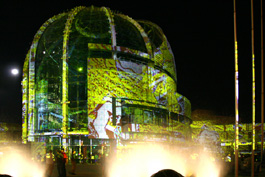
Click here to see the full-screen version of the above pic.
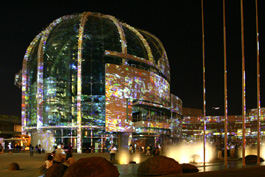
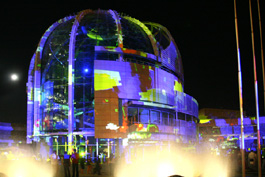
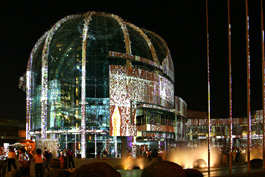
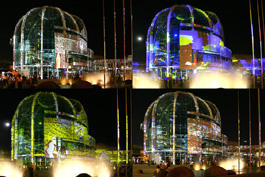
Symposium on Electronic Art. South Hall Exhibits.
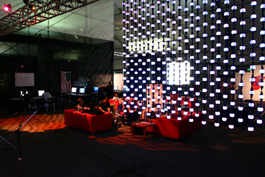
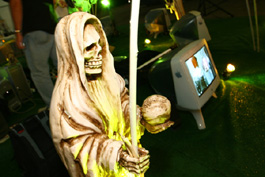
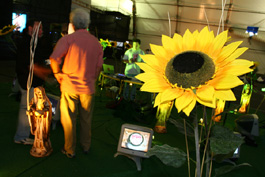
Posted Aug. 9, 2006
Urban Geo
By Gary Singh
Only at ZeroOne would you see a cavalcade of bicyclists named Glowlab taking to the streets of downtown San Jose to engage in psychogeography—the study of the specific effects of the geographical environment (whether consciously organized or not) on the emotions and behavior of individuals.
The Situationists appropriated the term from the Lettrists in the '50s, and it's basically a form of urban exploration where you map emotions onto the physical constructs of the environment in an attempt to avoid work and the banalities of the everyday urban experience. In French, the term is related to the concept of derive, which literally translates as "drifting," and in Situationist parlance it refers to locomotion without a goal or to a mode of experimental behavior having to do with a technique of rapid passage through varied ambiances.
In other words, it's all about finding new ways of exploring urban geography. Several different teams of cyclists turned downtown San Jose into a playing field for the course of 24 straight hours. The project is called drift.relay, and its playbook contains several instructions for the teams: assist, foul, offsides, lead, pass, fumble, intercept, shutout and many more.
And guess what? To open the whole thing up, Glowlab took to the streets at 10am Tuesday (Aug. 8), and one hour later, they wound up at the Caravan, downtown's legendary dive bar. I wonder what the daytime regulars thought. The entire adventure was/is being broadcast back to the South Hall of the convention center where folks could watch the cyclists taking on the streets of downtown San Jose. The next drift.relay takes place at the Conflux Festival in Brooklyn, the third annual festival for contemporary psychogeography.
Posted Aug. 9, 2006
Send a letter to the editor about this story.
|
|
|
|
|
|